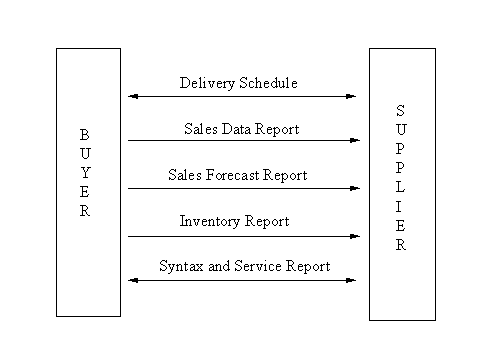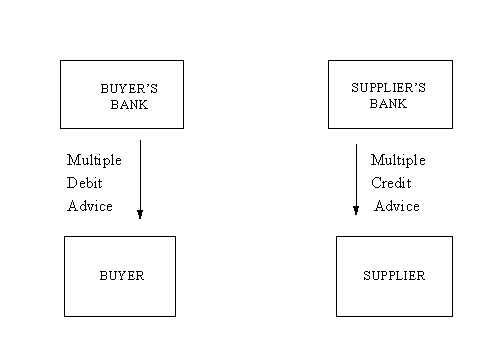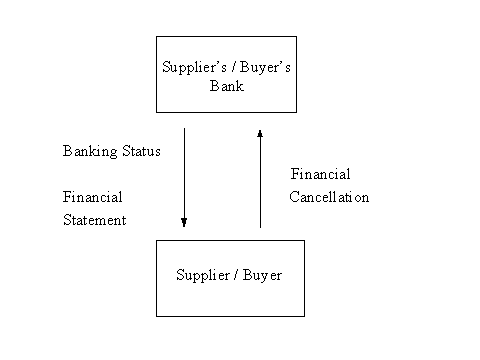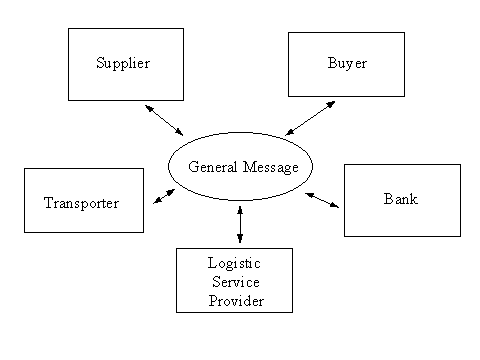
2. EANCOM MESSAGES
The Delivery Schedule is a message from a customer to his supplier providing product requirements for short term delivery instructions and/or long term product/service forecasts for planning purposes. The message can be used to authorise the commitment of labour and material resources. The message may provide schedules in two manners, by location, or by product. The message may also be sent by a supplier to a buyer as a response to a previously transmitted delivery schedule.
In its simplest form a location delivery schedule allows the user to specify one location and multiple products which are/will be required for that location. The simple product schedule allows the identification of one product which is/will be required in multiple locations. The two types of schedule must never be used together in one interchange. Only one type should be specified for each trading partner.
The Sales Data Report message sent from a seller to its supplier, headquarters, distribution centre or third party such as a marketing institute enables the transmission of sales data in a way that the recipient can process automatically. The message transmitting sales data by location in terms of product(s) identification, quantity sold, price, and promotions applicable can be used for production planning or statistical purposes. It should not be used to replace business transactions such as orders or delivery schedules.

The Sales Forecast Report message sent from a seller to its supplier, headquarters, distribution centre or third party enables the transmission of sales forecast data in a way that enables the recipient to process it automatically. The message transmitting sales forecast data by location in terms of product identification, forecasted quantities and promotions applicable can be used for production planning purposes. It should not be used to replace business transactions such as orders or delivery schedules.
The Inventory Report is a message between interested parties specifying information related to planned or targeted inventories. All goods, services and locations detailed in the inventory report will have been previously identified in the Party Information and Price/Sales Catalogue Messages. Different classes of inventories may be identified which may also be financially valued. Quantities may relate to model or target quantities, minimum/maximum levels, reordering levels and held stocks.
The Syntax and Service Report Message is used by the receiver of an EDIFACT message to acknowledge receipt of and/or detail any errors contained in an interchange. This message is used to report on the syntax level of a message and is not used to report on the business data contained.
The Syntax and Service Report may be carried out by a third party, i.e. a value added network, operating on behalf of the trading parties.
The Multiple Debit Advice message is sent by a Bank to its customer (normally the Buyer in EANCOM) to report amounts which have been (or will be) debited from the customer’s account in settlement of a referenced business transaction(s). A Multiple Debit Advice message may cover the financial settlement of one or more commercial trade transactions, such as invoices, credit notes, debit notes, etc.

The Multiple Credit Advice message is sent by a Bank to its customer (normally the Supplier in EANCOM) to report amounts which have been (or will be) credited to the customer’s account in settlement of a referenced business transaction(s). A Multiple Credit Advice message may cover the financial settlement of one or more commercial trade transactions, such as invoices, credit notes, debit notes, etc.
The Banking Status message is sent by a bank to its customer (usually the Buyer in EANCOM) providing status information on previously sent financial message. The Banking Status message may cover the response given to any previously sent message, such as a commercial or payment

instruction, a request for information, etc. This message provides a means to report on errors and inconsistencies found in the original message at application level. It is not intended to report on syntactical errors or to provide a non-repudiation response.
A Financial Cancellation message is sent by the Ordering Customer (usually the Buyer in EANCOM) to the Ordered Bank to request cancellation of a previously sent financial message(s), or one or many orders contained within a previously sent financial message(s). A Financial Cancellation message must always be responded to by a Banking Status message.
The Financial Statement message is sent by a financial institution to provide for a customer a statement of booked items confirming entries on the customer's account.
A Metered Services Consumption Report is a communication between trading parties, or their agents, providing consumption and where required associated technical information at a location(s) for a product(s) or service(s) where the supply is recorded using a meter(s). The Metered Services Consumption Report may be used to provide consumption information which may directly relate to other business functions, e.g. invoicing or process control.
A message to enable the transmission of the results of tests performed to satisfy a specified product requirement. The content includes, but is not limited to, test data and measurements, statistical information, and the testing methods employed.
The General Message may be used to send required data for which there is no specific standard message. It was designed primarily to facilitate early transmission testing between new EDI partners or to transmit text (preferably structured or coded) to supplement or further clarify previously transmitted EDI standard messages.

(c) Copyright EAN 1997